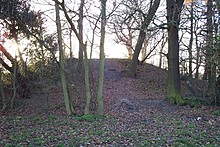|
|
|
|
Morden Park MoundRound Barrow(s)
|
||||||||||||||||||||||||
|
|
|
Images (click to view fullsize) |
|





|
Fieldnotes |
|
| Shortly after Professor Sheppard Frere gave his opinions that this mound was erected shortly after the Roman conquest, around 1958 my class were taken there when for some reason we were unable to use the playing fields alongside and our form master stated quite clearly that this was a bronze age barrow. Although he was something of a silly old fool, history and geography were his specialities and I'm sure he would have picked this up from an authorative source. So perhaps there was discussion and disagreement following the original pronouncements. |
Posted by Wild Wooder 30th December 2004ce |
|
Happpened upon Morden Park as a detour from wandering along the River Wandle nearby… Despite the iffy history (Roman; built upon previous older pre-historic remains and burial ground?) it is a clearly contrived mound built for some special purpose that makes you wonder. Sadly littered and graffitied, with the mentioned information sign at the top of the mound removed, probably vandalised; (and yes - if you can deal with the muddy trek!) - despite that it is a wee oasis of calm in London, and commands quite a dominant position in the landscape with views all around, especially more spectacular at this time of year looking at the Winter sun setting through the trees… |
 Posted by Jonnee23
Posted by Jonnee2328th December 2004ce |
|
[visited about 29/1/03] Mud mud glorious mud. I foolishly thought that a London park would be non-muddy in January and my trainers paid for it here. This is a large tree covered mound with a kinda obvious ditch around the outside. As has been said it was once used as a tea-house and I found some pretty remains of a plate at the top. The views from here are hidden slightly by the college nearby, but I was able to see the London Eye, about 10 miles to the North which was nice. I imagine the views when the mound was built were to the horizon in all directions, or at least to the hills in the distance to the south and west, which are 15 odd miles away. Oh and it looks damn like a classic round barrow to me! And finally, I picked up a carrier bags worth of rubbish from this and could have had 2 or 3 more. Someone needs to teach the local kids to take their Hooch bottles away with them... |
 Posted by juamei
Posted by juamei4th February 2003ce |
|
It would be nice to have more up to date info on this mound as the last research done was in the 50s. If it was a "Roman" burial mound it must have been enormous as the present mound has been "truncated and spread" and is still large. Info at the site mentions that it was built over a previous barrow! It's position commands extensive views in all directions and would have been visible for miles. Was it the site of the burial of an impotrant chief as it's dominant position suggests? There are few enough prehistoric/Roman structures to be seen in the London area perhaps this is one that has escaped the net. Disabled: Car park within 100M, Level, mown grass. |
 Posted by jimit
Posted by jimit31st January 2003ce Edited 8th December 2003ce |
Miscellaneous |
|
|
".... In the 1950's the late Dr. Crawford of the OS thought its appearance warranted its marking as an ancient burial mound on OS maps. At the same time, Professor Sheppard Frere inspected it and gave his opinion that it was a native British pagan burial mound probably erected shortly after the Roman Conquest of Britain when native Iron Age customs still persisted. He noted in particular its large size and steep sides, characteristic of burial mounds of that period. Opinions of such eminence must be accepted, but proof could only be obtained by excavation, which would not be appropriate. However, other evidence may support the theory that the Mound already existed before the formation of the estate in the late 18C. Early 18C maps do not show this feature, but local field names may provide some clues to its earlier existence. From Tudor times onwards, one of the large fields here was called ' Gallowsfield' and there are a number of instances in Surrey of such a name being associated with burial mounds. Again an 'Extent' or valuation of Westminster Abbey's manor of Morden, taken in 1312, includes land called 'Dedemanforlonges' in a list of the demesne lands, which were mostly in the area either side of London Road between Morden Park and Morden Hall. The name may possibly refer to a burial mound, though it may merely refer to memorable death in the area. ....." Extract from "Morden Park" Merton Library Service on behalf of The Merton Hist. Soc. Sept.2002 ISBN 0905174402 This seems as far as one can go with this enigmatic mound until new excavations can confirm its true antiquity. |
 Posted by jimit
Posted by jimit15th April 2003ce |
|
Another mound in a london park, another mess of modifications & history. Like Henry VIII Mound, this was last used as a Belvedere. It had a possible 18th/19th century summer house on top, together with a spiral path for presumably easy access. From GLSMR: Originally it was probably a Roman era mound as it is too large to be a bell barrow. It has a ditch around it, a 10-15ft berm and as far as I can tell it has never been excavated. |
 Posted by juamei
Posted by juamei31st January 2003ce Edited 31st January 2003ce |

